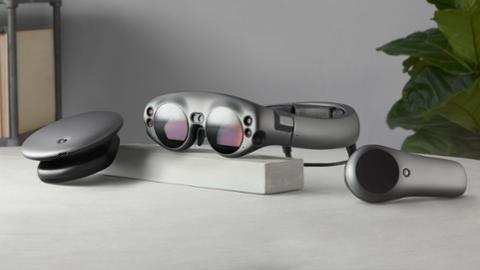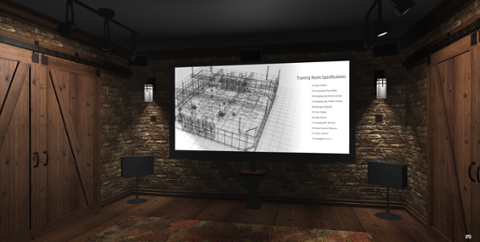 After years of rumors, augmented-reality company Magic Leap has unveiled its first generation of AR hardware, which it claims will arrive sometime in 2018. The “Magic Leap One” includes a pair of AR goggles, a hand controller, and a belt-mounted “Lightpack” that holds the processor and other hardware. The goggles (which look quite a bit like the ones Vin Diesel wore as extraterrestrial conman Richard B. Riddick in the “Riddick” movies) will supposedly support multiple AR environments simultaneously, so a user could leave “open” business and entertainment experiences in the same space. A reporter from Rolling Stone recently engaged in a lengthy demo session with the Magic Leap goggles and came away impressed, although the hardware isn’t yet powerful enough to make experiences indistinguishable from reality. In interacting with a virtual character, he wrote: “The level of detail was impressive, though I wouldn’t mistake her for a real person, there was something about her luminescence, her design, that gave her away.” Magic Leap also plans on launching a developer portal in early 2018, which will include an SDK, documentation, and support. Beyond that, however, the company has provided precious little detail with regard to hardware or software specs. Nonetheless, a glimpse of finalized hardware may put to rest all the accusations that Magic Leap had taken millions of dollars in venture funding with only vaporware to show for it. In February 2017, Business Insider Tweeted out an image of Magic Leap’s AR testing rig, a massive device that looked like a ‘Ghostbusters’ proton pack. That clunky backpack, combined with a handheld battery pack and chunky eyewear, didn’t exactly inspire confidence that Magic Leap was anywhere close to a finished product. “To all the @magicleap fans: we will not let you down. Back to heads down mode so we can finish and ship,” Magic Leap CEO Rony Abovitz wrote on Twitter after that image leaked. Over the past 11 months, Magic Leap seems to have shaped that prototype into something that more closely resembles the HoloLens, Microsoft’s much-publicized AR headset. Yet even if Magic Leap makes its 2018 deadline, it will face substantial competition not from dedicated devices like the HoloLens, but millions of iPhones and Google Android devices with AR capability. If Magic Leap wants to succeed in this environment, it will need to market its capabilities as far more immersive than what iOS and Android can possibly offer; and the price point (as yet undisclosed) will need to be reasonable.
After years of rumors, augmented-reality company Magic Leap has unveiled its first generation of AR hardware, which it claims will arrive sometime in 2018. The “Magic Leap One” includes a pair of AR goggles, a hand controller, and a belt-mounted “Lightpack” that holds the processor and other hardware. The goggles (which look quite a bit like the ones Vin Diesel wore as extraterrestrial conman Richard B. Riddick in the “Riddick” movies) will supposedly support multiple AR environments simultaneously, so a user could leave “open” business and entertainment experiences in the same space. A reporter from Rolling Stone recently engaged in a lengthy demo session with the Magic Leap goggles and came away impressed, although the hardware isn’t yet powerful enough to make experiences indistinguishable from reality. In interacting with a virtual character, he wrote: “The level of detail was impressive, though I wouldn’t mistake her for a real person, there was something about her luminescence, her design, that gave her away.” Magic Leap also plans on launching a developer portal in early 2018, which will include an SDK, documentation, and support. Beyond that, however, the company has provided precious little detail with regard to hardware or software specs. Nonetheless, a glimpse of finalized hardware may put to rest all the accusations that Magic Leap had taken millions of dollars in venture funding with only vaporware to show for it. In February 2017, Business Insider Tweeted out an image of Magic Leap’s AR testing rig, a massive device that looked like a ‘Ghostbusters’ proton pack. That clunky backpack, combined with a handheld battery pack and chunky eyewear, didn’t exactly inspire confidence that Magic Leap was anywhere close to a finished product. “To all the @magicleap fans: we will not let you down. Back to heads down mode so we can finish and ship,” Magic Leap CEO Rony Abovitz wrote on Twitter after that image leaked. Over the past 11 months, Magic Leap seems to have shaped that prototype into something that more closely resembles the HoloLens, Microsoft’s much-publicized AR headset. Yet even if Magic Leap makes its 2018 deadline, it will face substantial competition not from dedicated devices like the HoloLens, but millions of iPhones and Google Android devices with AR capability. If Magic Leap wants to succeed in this environment, it will need to market its capabilities as far more immersive than what iOS and Android can possibly offer; and the price point (as yet undisclosed) will need to be reasonable. Magic Leap Unveils AR Prototype, Promises Dev Tools
 After years of rumors, augmented-reality company Magic Leap has unveiled its first generation of AR hardware, which it claims will arrive sometime in 2018. The “Magic Leap One” includes a pair of AR goggles, a hand controller, and a belt-mounted “Lightpack” that holds the processor and other hardware. The goggles (which look quite a bit like the ones Vin Diesel wore as extraterrestrial conman Richard B. Riddick in the “Riddick” movies) will supposedly support multiple AR environments simultaneously, so a user could leave “open” business and entertainment experiences in the same space. A reporter from Rolling Stone recently engaged in a lengthy demo session with the Magic Leap goggles and came away impressed, although the hardware isn’t yet powerful enough to make experiences indistinguishable from reality. In interacting with a virtual character, he wrote: “The level of detail was impressive, though I wouldn’t mistake her for a real person, there was something about her luminescence, her design, that gave her away.” Magic Leap also plans on launching a developer portal in early 2018, which will include an SDK, documentation, and support. Beyond that, however, the company has provided precious little detail with regard to hardware or software specs. Nonetheless, a glimpse of finalized hardware may put to rest all the accusations that Magic Leap had taken millions of dollars in venture funding with only vaporware to show for it. In February 2017, Business Insider Tweeted out an image of Magic Leap’s AR testing rig, a massive device that looked like a ‘Ghostbusters’ proton pack. That clunky backpack, combined with a handheld battery pack and chunky eyewear, didn’t exactly inspire confidence that Magic Leap was anywhere close to a finished product. “To all the @magicleap fans: we will not let you down. Back to heads down mode so we can finish and ship,” Magic Leap CEO Rony Abovitz wrote on Twitter after that image leaked. Over the past 11 months, Magic Leap seems to have shaped that prototype into something that more closely resembles the HoloLens, Microsoft’s much-publicized AR headset. Yet even if Magic Leap makes its 2018 deadline, it will face substantial competition not from dedicated devices like the HoloLens, but millions of iPhones and Google Android devices with AR capability. If Magic Leap wants to succeed in this environment, it will need to market its capabilities as far more immersive than what iOS and Android can possibly offer; and the price point (as yet undisclosed) will need to be reasonable.
After years of rumors, augmented-reality company Magic Leap has unveiled its first generation of AR hardware, which it claims will arrive sometime in 2018. The “Magic Leap One” includes a pair of AR goggles, a hand controller, and a belt-mounted “Lightpack” that holds the processor and other hardware. The goggles (which look quite a bit like the ones Vin Diesel wore as extraterrestrial conman Richard B. Riddick in the “Riddick” movies) will supposedly support multiple AR environments simultaneously, so a user could leave “open” business and entertainment experiences in the same space. A reporter from Rolling Stone recently engaged in a lengthy demo session with the Magic Leap goggles and came away impressed, although the hardware isn’t yet powerful enough to make experiences indistinguishable from reality. In interacting with a virtual character, he wrote: “The level of detail was impressive, though I wouldn’t mistake her for a real person, there was something about her luminescence, her design, that gave her away.” Magic Leap also plans on launching a developer portal in early 2018, which will include an SDK, documentation, and support. Beyond that, however, the company has provided precious little detail with regard to hardware or software specs. Nonetheless, a glimpse of finalized hardware may put to rest all the accusations that Magic Leap had taken millions of dollars in venture funding with only vaporware to show for it. In February 2017, Business Insider Tweeted out an image of Magic Leap’s AR testing rig, a massive device that looked like a ‘Ghostbusters’ proton pack. That clunky backpack, combined with a handheld battery pack and chunky eyewear, didn’t exactly inspire confidence that Magic Leap was anywhere close to a finished product. “To all the @magicleap fans: we will not let you down. Back to heads down mode so we can finish and ship,” Magic Leap CEO Rony Abovitz wrote on Twitter after that image leaked. Over the past 11 months, Magic Leap seems to have shaped that prototype into something that more closely resembles the HoloLens, Microsoft’s much-publicized AR headset. Yet even if Magic Leap makes its 2018 deadline, it will face substantial competition not from dedicated devices like the HoloLens, but millions of iPhones and Google Android devices with AR capability. If Magic Leap wants to succeed in this environment, it will need to market its capabilities as far more immersive than what iOS and Android can possibly offer; and the price point (as yet undisclosed) will need to be reasonable. 


